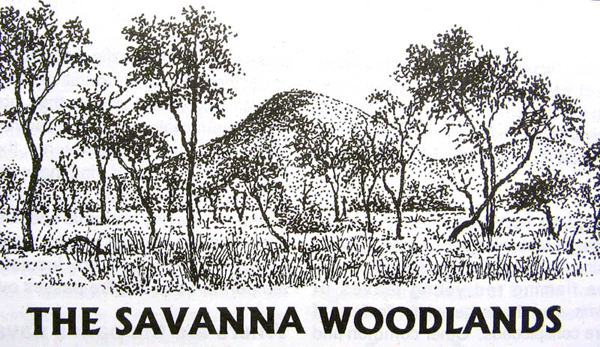
What is Savannah?
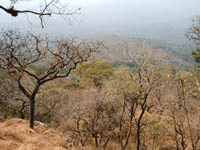
Savannah is vegetation characterised by its ground cover of coarse, tall grasses 2-3 metres high, among which small gnarled trees stand, usually so far apart that the sun has little or no difficulty in penetrating to the ground or at least to the herbaceous layer. The term "savannah" is used to cover a wide expanse and a variety of African vegetation, here it is taken to include all areas of woodland and grassland within the park.
How Does Savannah Differ From Rainforest?
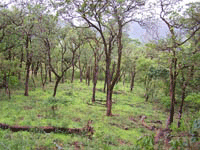
Savannah areas of the park differ from rainforest in a number of distinct ways. Savannah habitat is drier and supports far fewer species than rainforest, both trees and animals. Trees in the savannah are generally much smaller, only reaching heights of 12 metres, frequently they appear gnarled and misshapen because of frequent burning and regrowth. Many tree species lose their leaves at the beginning of the dry season though most of this leaf litter is burnt annually and does not decompose gradually as it does in the rainforest.
The dispersal distribution of savannah trees allows light and warmth to reach the soil. Unlike the dark rainforest there is no closed canopy overhead to block out the sun's rays and under these conditions grasses grow and flourish, providing an abundant and easily obtainable source of food for large herbivores. Tall grasses can be up to 4 metres tall in places by the end of the wet season although grasses are noticeably shorter than this in the Northern park sector. As well as food for herbivores, grasses provide cover and shelter for many species of mammals, birds, reptiles, and invertebrates.
Savannah and Fringing Forests
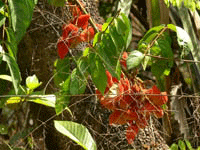
In savannah areas, fringing forests along streams and rivers may be the most striking feature of the vegetation. In the late dry season the flaming red young leaves of Brachystegia eurycoma , and the large white flowers of Berlinia grandiflora are conspicuous. Other common and widespread fringing forests trees are the sasswood ( Erythrophleum suaveolens ) and the screw-pine ( Pandanus candelabrum ). The importance to wildlife of such forest corridors criss-crossing the savannah is great. Here, right in the savannah itself, may be found species more usually associated with forest habitat, such as Colobus monkeys, bushbuck and Red-flanked duiker.
Fire
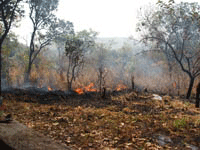
Fire is a well known feature of African savannahs although its use and importance is often misunderstood. Savannahs immediately after a fire appear bleak and desolate places, the park visitor may be initially confused or dismayed by the apparent destruction. Please do not be worried, fire is an important tool for park managers who us it to promote diversity and stability. After burning the ground is covered with a layer of ash, which gradually adds nutrients to the soil. Within a remarkable short time, and without the stimulus of any rain, fresh green shoots of grass appear, followed by new foliage on the trees that also burst into flower during the dry season months. Replacing old dead grass with fresh new palatable grass provides important pasture for grazing animals at a time when declining levels of rainfall have caused the remaining grasses to wither and die. Hartebeest, for example, quickly move into burnt areas just as the first shoots of green grass begin to sprout through the ashes.
Most burning is timed to occur at the beginning of the dry season, in December or January, when the vegetation is still only partially dry. Burning early removes the accumulated dead leaf litter and prevents the occurrence of fires later in the dry season, which are hotter and more destructive of young trees. Burning early thus acts to protect trees whilst providing park animals with an important, highly palatable food supply at a difficult time of the year. Pastoral peoples practice burning in an identical manner to provide fresh grazing for their livestock. Still, there is also concern that fires eat slowly but steadily into the edges of the rainforest which, as a result, shrink more and more at the expense of woodland-savannah.
Animal activity during this time is great. Herbivores find their richest feeding of the year among the succulent young grass shoots and prolific root-suckers sent up by the trees, and in the more open conditions carnivores are more easily able to detect and pursue their prey; only seed and fruit eating mammals are at a disadvantage and must rely to some extend upon buried stores, though the fruits of a few savannah trees ripen during these months and a number of species of fig bear fruit also.
It is worth remembering that fire rarely kills any mammal species. Larger species move temporarily away and smaller species are able to hide in burrows where they are insulated from high surface temperatures as the fire passes overhead.
Mammals of the Savannah
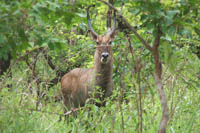
Compared to rainforests the widespread savannah areas of the park support a very different fauna. There are two main reasons for this contrast. Firstly, the open woodland and low shrub structure of the savannah is generally unsuitable for arboreal and other rainforest mammals. Secondly, extensive savannah grasslands provide food for large number of grass-eating herbivores, food which is absent from rainforests. Although savannah contains fewer numbers of different mammal species than does rainforest it nevertheless supports a higher biomass (or greater total number) of mammals.
